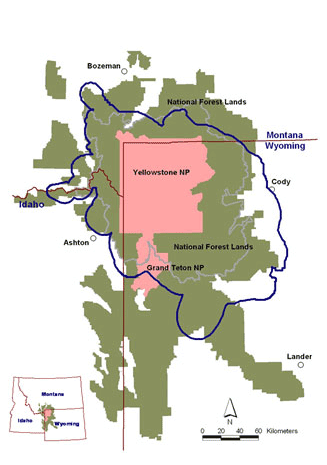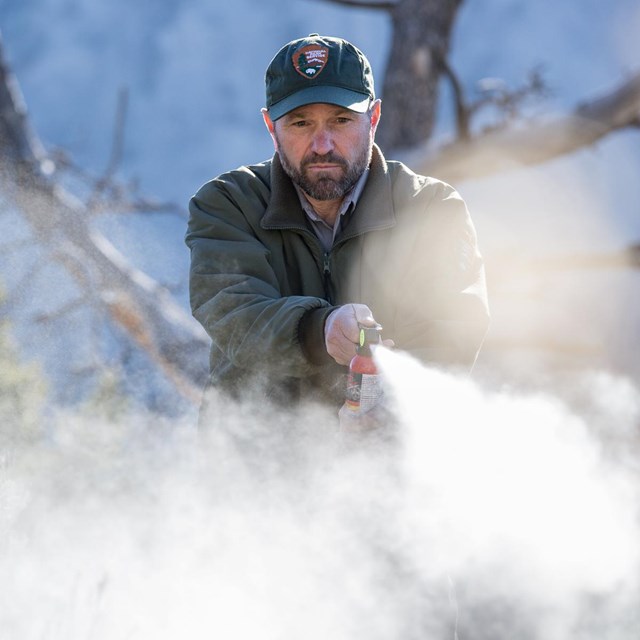Greater Yellowstone Grizzly Population Separate Greater Yellowstone Grizzly Population Continuity
In September 2018, a federal judge restored protections for grizzly bears within the Greater Yellowstone Ecosystem under the Endangered Species Act. This decision came after the U.S. Fish & Wildlife Service removed those protections, or "delisted" the bears, in July 2017. This is a significant decision for the management of bears and it cancelled the Wyoming and Idaho hunts that were planned on state lands for Fall 2018. As always, hunting will remain prohibited inside Yellowstone National Park.
The Yellowstone population of grizzly bears was designated, or listed, as threatened with extinction in 1975. Various agencies and stakeholder groups hold differing opinions about the status of the population and how it should be managed in the future. We'd like to share our thoughts about grizzly bears and their conservation.
1. Grizzlies have made a remarkable recovery. The growth and expansion of the grizzly bear population in the Greater Yellowstone Ecosystem (GYE) is a remarkable conservation success story. The population has grown from 136 in 1975 to about 728 in 2019 using a population estimate model called Chao2. Scientists think the Yellowstone area population is recovered and may have reached its capacity for resident grizzlies in many areas of the ecosystem. Efforts to reduce conflicts with people and preserve habitat for dispersal and, eventually, connectivity with other populations outside of the GYE will be essential for further restoration.
2. Management of bears will not change in the national parks. The conservation and management of grizzly bears inside Yellowstone and Grand Teton national parks will not change significantly through this listing and delisting process. We will continue to prevent bears from obtaining human foods, preserve wilderness to minimize human-caused mortalities and disturbances, and maintain our long-term monitoring program. We value grizzlies as a dominant species in the ecosystem—and one that offers amazing wildlife viewing opportunities. Millions of people visit the park with the intention of seeing bears and connecting with the wildness of nature. Wildlife watching also brings economic benefits worth tens of millions of dollars to the region. We are proud that Yellowstone and Grand Teton national parks will continue to be the heart of the grizzly population keeping this magnificent species in the wild..
3. Reducing conflicts with people is the key to grizzly conservation. Employing best practices for safety in bear country doesn't just protect people, but the welfare of animals as well. When bears kill people or damage property, bears lose. If you care about grizzly bears, learn how to share the landscape with them responsibly.
4. We will work with the U.S. Fish & Wildlife Service, surrounding states, communities, and American Indian tribes as the delisting conversation continues in the future. The U.S. Fish & Wildlife Service is the federal agency that administers the Endangered Species Act. They make all decisions about listing and delisting in consultation with other agencies, tribes, states, and the public. The National Park Service will continue to be actively engaged with these partners and provide scientific data related to population estimates, habitat, genetics, and population connectivity.
History of Listing & Delisting (1975 to 2018)
On July 28, 1975, under the authority of the Endangered Species Act, as amended, the U.S. Fish & Wildlife Service listed four distinct populations of grizzly bear in the lower 48 states as "threatened," in part, because the species was reduced to only about 2% of its former range south of Canada. Five or six small populations were thought to remain, totaling 800 to 1,000 bears. The southernmost—and most isolated—of those populations was in the Greater Yellowstone Ecosystem (GYE), where 136 grizzly bears were thought to live in the mid-1970s. The goal of an Endangered Species Act listing is to recover a species to self-sustaining, viable populations that no longer need protection. To achieve this goal, federal and state agencies:
- Stopped the grizzly hunting seasons in the Greater Yellowstone Ecosystem (outside national park boundaries).
- Established the Yellowstone grizzly bear recovery area (Yellowstone National Park, John D. Rockefeller, Jr. Memorial Parkway, portions of Grand Teton National Park, national forests surrounding Yellowstone, Bureau of Land Management lands, and state and private land in Idaho, Montana, and Wyoming).
- Created the Interagency Grizzly Bear Study Team to coordinate bear research and monitoring among the federal agencies and state wildlife managers; the team monitors bear populations and studies grizzly bear food habits and behavior.
- Established the Interagency Grizzly Bear Committee to increase communication and cooperation among managers in all recovery areas, and to supervise public education programs, sanitation initiatives, and research studies.

The Grizzly Bear Recovery Plan was established in 1993 and revised in 2006. This plan guides management when the grizzly is on the threatened species list.
Bear managers will use the Grizzly Bear Conservation Strategy if the GYE population of grizzly bear is removed from the threatened and endangered species list. The Conservation Strategy is the long-term guide for managing and monitoring the grizzly bear population and assuring sufficient habitat to maintain recovery. It emphasizes coordination and cooperative working relationships among management agencies, landowners, and the public to ensure public support, continue the application of best scientific principles, and maintain effective actions to benefit the coexistence of grizzlies and humans. It incorporates existing laws, regulations, policies, and goals. The strategy has built-in flexibility:
- Grizzly–human conflict management and bear habitat management are high priorities in the recovery zone, which is known as the Primary Conservation Area. Bears are favored when grizzly habitat and other land uses are incompatible; grizzly bears are actively discouraged and controlled in developed areas.
- State wildlife agencies have primary responsibility to manage grizzly bears outside of national parks, including bears on national forests; national parks manage bears and habitat within their jurisdictions.
- State and federal wildlife managers will continue to monitor the grizzly population and habitat conditions using the most feasible and accepted techniques.
- Managers will remove nuisance bears conservatively and within mortality limits outlined above, and with minimal removal of females; they will emphasize removing the human cause of conflict rather than removing a bear.
- Outside the Primary Conservation Area, states develop management plans that define how grizzly bears are to be managed.
Timeline
- 1975: The grizzly bear was listed as a threatened species, which required recovering the species to a self-sustaining population.
- 1993: A recovery plan is implemented with three specific recovery goals that have to be met for six consecutive years.
- 2000: Draft Conservation Strategy for the Grizzly Bear in the Greater Yellowstone Ecosystem is completed.
- 2002: Conservation Strategy is approved after public comment period—16,794 comments were received. It will be implemented when the grizzly is removed from the threatened species list.
- 2003: Recovery goals are met for the sixth year in a row.
- 2005: U.S. Fish & Wildlife Service proposes removing the grizzly bear from the threatened species list.
- 2006: The Grizzly Bear Recovery Plan is modified to update methods of estimating population size and sustainable mortality.
- 2007: The Greater Yellowstone Ecosystem distinct population segment of grizzly bear population is removed from the threatened species list. Conservation Strategy is implemented. Several groups file lawsuits challenging the decision.
- 2009: A federal district judge overturned the delisting ruling, placing grizzly bears back on the threatened species list claiming: (1) the Conservation Strategy was unenforceable, and (2) that the U.S. Fish & Wildlife Service did not adequately consider the impacts of the potential loss of whitebark pine nuts, a grizzly bear food source.
- 2010: The U.S. Fish & Wildlife Service appeals the decision to keep the grizzly bear on the threatened species list.
- 2011: An appeals court rules the grizzly bear should remain on the threatened species list. They determined that the Conservation Strategy did in fact provide adequate regulatory mechanisms were in place. But the court upheld the lower court ruling that the U.S. Fish & Wildlife Service did not sufficiently address the potential impacts from reduction of whitebark pine and other foods.
- 2013: Yellowstone Ecosystem Subcommittee, the Interagency Grizzly Bear Committee, and Interagency Grizzly Bear Study Team recommend that grizzly bears be removed from the threatened species list because alternative foods are available and the reduction of whitebark pine is not having a significant impact on bears at this time.
- 2017: U.S. Fish & Wildlife Service removes the Yellowstone population of grizzly bears from the threatened species list.
- 2018: A U.S. District Judge restored protections for the Yellowstone-area population of grizzly bears under the Endangered Species Act.
-

Bear Management
Bear management has evolved since the park was established.
-

Bear Spray
Learn about this highly effective bear deterrent.
Source: https://www.nps.gov/yell/learn/nature/bearesa.htm
0 Response to "Greater Yellowstone Grizzly Population Separate Greater Yellowstone Grizzly Population Continuity"
Post a Comment